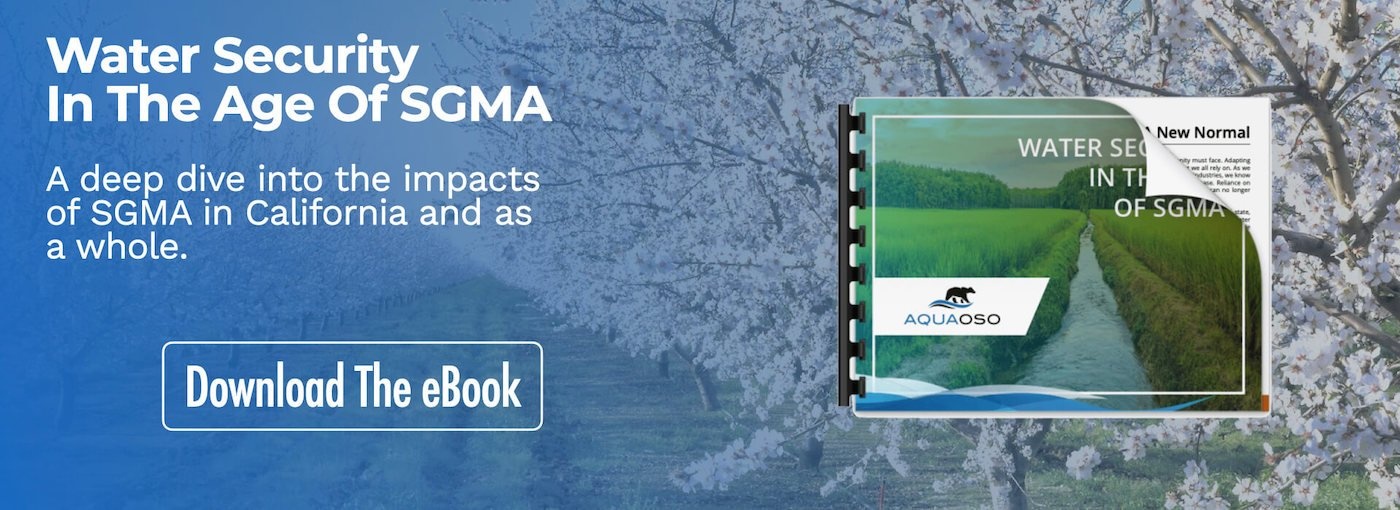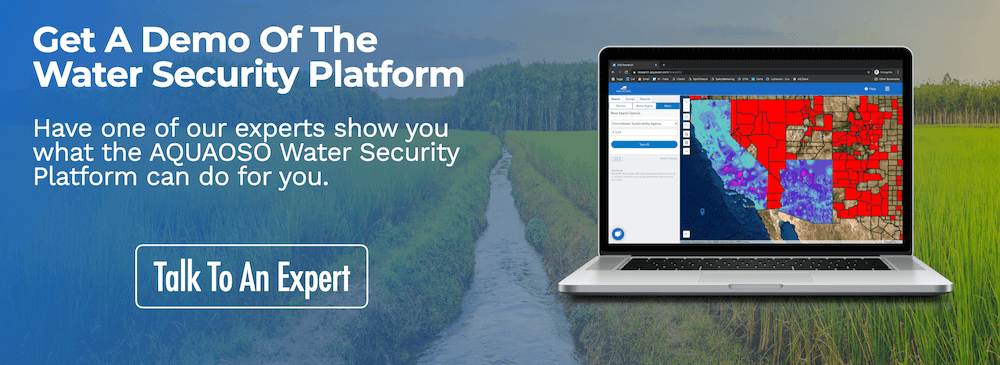The Physical Risk of Water Issues in Agricultural Finance
Agricultural lenders and investors face a range of risks to their portfolios when it comes to water issues, particularly in the context of climate change. These include policy and legal risks, market risks, reputation risks, and more. One of the most important risk factors to consider is physical risk, which can impact water availability and disrupt supply chains.
Physical risks can be either acute – such as extreme weather events – or chronic, such as long-term changes to weather patterns and temperatures. Not only can physical risks impact the viability of an agricultural operation, but they can also have adverse impacts on the well-being of nearby communities who share the same limited water resources.
This post will cover some of the most common examples of physical risk in agriculture, as well as tools that lenders and investors can use to mitigate them.
What Are Physical Risks in Agriculture?
According to the U.N.’s Principles of Responsible Investment, the agricultural sector “is the largest global user of water, [but] supply of and demand for water by basin and crop vary considerably.” This means that water is one of the core assets in farming that can be impacted by physical risks caused by environmental drivers like climate change.
As the P.R.I. puts it, “Water risk is not only linked to how a producer could affect others downstream (impacts) but how reliant they are on others upstream (dependencies).”
One common type of water risk is water stress, in which a region has insufficient water resources to meet the needs of all of its users. This could be due to the overpumping of groundwater resources, resulting in aquifer depletion, and/or long-term drought caused by changing rainfall or snowmelt patterns. This stress can lead to increased water costs and increased competition for water rights in affected basins.
Not all physical water risks are caused by water shortages, however. In some regions, a sudden overabundance of water – such as flooding – can be a danger to crop health. In a similar way, slow but steady changes to soil and water quality – such as erosion, land subsidence, and salinization – can cause unexpected physical risks.
Physical Risks for Ag Lenders and Investors
When assessing the potential impacts of physical risks in agriculture, it’s important to differentiate between acute risks and chronic risks:
- Acute risks are those associated with specific events, such as droughts, floods, fires, hurricanes, and other extreme weather events.
- Chronic risks are those that take place over a longer timeframe, such as sea-level rise, heat waves, and other changes to climate patterns.
Both types of risks should be factored into lending and investment decisions in the form of water risk assessments and risk mitigation strategies. While acute risks may be more likely to cause sudden and immediate crop damage, chronic risks can result in lower crop yields and reduced financial success over time.
An article in the Cornell Chronicle points out that, in the age of climate change, farmers can either “risk more revenue volatility or live with a more predictable decrease in crop yields”. For example, in the Yakima River Basin in Washington State,
“A complex combination of snow, reservoirs and water rights controls the availability of irrigation water. That water dictates the success of some of the largest producers of wheat, corn, potatoes, pears, cherries, grapes, apples and hops in the U.S.”
In good years, the basin accounts for $4 billion in crops. However, physical risks such as water stress and increased temperatures can lead to revenue volatility and make it harder for farmers to predict yields.
In regions like this, ag lenders and investors must perform more due diligence in their portfolios and take the necessary steps according to what they find.
Using Scenario Analysis to Assess Physical Risk
A report by Ceres found that “U.S. banks are taking too narrow of an approach when disclosing their exposure to climate risk and are potentially underestimating possible losses.” One solution is to use scenario analysis to assess and mitigate these risks, which involves ascertaining the impact of both likely and unlikely scenarios.
The Task Force on Climate-related Financial Disclosures recommends that financial institutions use scenario analysis to “evaluate the potential impact of climate-related scenarios on individual assets or investments, investments or assets in a particular sector or region, or underwriting activities.”
These can be either quantitative – incorporating hard data – or qualitative, which may include assessing societal or business relationships for which numerical figures don’t exist. A scenario analysis can help organizations identify areas that need more monitoring, as well as potential strategies for mitigating acute and chronic risks.
Limitations of Scenario Analysis
Although performing a scenario analysis can be useful in many contexts, there are still some limitations to be aware of. In particular, organizations may lack the granular data they need to perform a truly comprehensive scenario analysis.
For example, the Task Force recommends using a 2°C scenario because it serves as a “common reference point.” But it also notes that “these climate-related scenarios do not always provide the ideal level of transparency, range of data outputs, and functionality of tools that would facilitate their use in a business or investment context.”
Ag professionals may want to incorporate more granular datasets, such as water GIS data, to perform an analysis on a specific basin or parcel of land. Without the right tools to gather and analyze this data, a scenario analysis can be costly – especially for large portfolios that include investments in multiple industries or regions.
Scenario analysis is a new approach for many industries, requiring professionals to be proactive and take the initiative to gather the data they need.
How AQUAOSO Can Help Monitor Physical Risk
AQUAOSO’s Water Security Platform was designed specifically with ag professionals in mind and can help address many of the issues encountered when performing a water risk assessment or scenario analysis. In particular, AQUAOSO facilitates granular data collection, both from publicly-available datasets, as well as from growers who may be collecting data from field sensors and other real-time data sources.
Users can organize and present that data in an easy-to-understand way and share it with other stakeholders through a central, collaborative platform. This allows for more advanced scenario planning that results in actionable, parcel-specific insights.
Plus, because it’s cloud-based and customizable, it saves organizations the time and expense of developing their own proprietary platforms. Ultimately, lenders and investors can make better, more informed decisions about water risk as part of a comprehensive physical risk mitigation strategy.
Read about ESG reporting and capital risk in the explorable AQUAOSO Guide
The Bottom Line
Physical risks are a growing concern for ag lenders and investors seeking to assess the overall risk of their portfolios in light of climate change. These include acute risks, such as extreme weather events, and chronic risks, such as changing weather patterns. The Task Force on Climate-related Financial Disclosures suggests that financial institutions perform a scenario analysis as a way to identify and mitigate these risks.
However, many current tools and datasets may be lacking the granular insights that ag professionals need. AQUAOSO developed a platform specifically for ag professionals to gather information on water risk.
The Research and Reporting tool offers an easy way to access and interpret water GIS data, while the Portfolio Connect tool presents this data in a collaborative format that’s easy to share with other stakeholders.
Contact AQUAOSO today to learn more about the Water Security Platform, or sign up for the newsletter to stay up-to-date on this and other agricultural issues.
Recent Posts
Agcor and AgWare Celebrate 2 Years of Groundbreaking Integration, Setting the Standard in Agricultural Appraisal Efficiency
PRESS RELEASE For Immediate Release DENVER, March 21, 2024 -- Agcor, an AQUAOSO Technologies, PBC brand, a leading provider of agricultural lending software solutions, announces a significant milestone in its partnership with AgWare, a premier developer of innovative...
AQUAOSO launches Agcor – a full suite of digital tools for the modern ag lender.
PRESS RELEASE For Immediate Release Denver, CO - Today, AQUAOSO Technologies, PBC officially unveiled Agcor™ - a suite of software tools for the modern ag lender. The software is purpose-built by and for agricultural lenders to unlock the power of...
AQUAOSO’s Climate Intelligence Platform Showcased At OnRamp Conference
PRESS RELEASE For Immediate Release AQUAOSO showcases GIS Connect, a climate intelligence platform that helps US financial institutions mitigate climate risk during the recent OnRamp Agriculture conference. AQUAOSO shares their story of substantial growth as...



